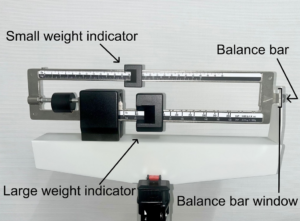Main Body
Weight and Height
Weight refers to the amount that a person weighs (ie., how heavy they are) and is typically reported in kilograms in Canada (metric system). However, if you ask clients their weight, they will probably provide it to you in pounds (imperial system). Thus, you may need to convert weight from the imperial to the metric system and vice versa. 1 kilogram = 2.2 lbs. Thus, if a client tells you that they are 50 lbs, then to convert to kg, you would divide 50 by 2.2 which equals 22.7 kg.
Height refers to the distance upward (ie., how tall a person is) and is typically reported by healthcare professionals in metres/centimetres in Canada (metric system). However, if you ask clients their height, they will probably provide it to you in feet/inches (imperial system). Thus, you may need to convert height from the imperial to the metric system and vice versa. 1 metre = 3.28 feet = 39.37 inches (1 foot = 12 inches). Thus, if a client tells you that they are 5.2, then to convert to metres, you would divide 5.2 by 3.28 = 1.58 metres.
These measurements are often assessed together particularly in childhood and adolescence and/or with a first healthcare visit. In adulthood, weight is often assessed as needed during preventative primary healthcare visits or at each visit with a specialist when undergoing long-term treatments for conditions such as cancer, diabetes, and heart failure.
Weight measurement
In a primary care setting, weight measurement is usually done on a mechanical beam scale, which has a balance bar as opposed to a digital scale. They have been shown to be more accurate than digital scales. See Figure 1.
If using a mechanical beam scale, the steps in measuring weight are:
- Ensure accurate calibration by checking to see that the balance bar is in the middle of the balance bar window when the small and large weight indicators are at zero.
- Ask the client to remove their shoes and any heavy garments such as a coat. If there are concerns, you may have the client wear a gown.
- Ask the client to step on the scale. (when they do so, the balance bar will move up)
- Now, you will move the large weight indicator followed by the small weight indicator until the balance bar is in the middle of the balance bar window. If the balance bar is above the middle of the balance bar window, you need to increase the weight indicators. If the balance bar is below the middle of the balance bar window, you need to decrease the weight indicators.
- You can note the weight when you have adjusted the weight indicators until the balance bar is in the middle of the balance bar window. To note the weight, you should add the large and small weight indicators together.
- For example, in Figure 1, the weight in pounds is 72.8 lbs. Since 1 kg =2.2 lbs, you would divide 72.8 lbs by 2.2 to get a weight of 33.09 kg.
Here is a video that shows you how to use a mechanical beam scale, although please note it is in pounds.

Figure 1: Mechanical beam scale (illustrated by Tayiba Rahman)
Height measurement
Height measurement can be done with a device that consists of a vertical ruler and an adjustable horizontal height rod that can be adjusted up or down so that the headpiece rests on the crown of the head (i.e., the top of the head). See Figure 2. This device is often attached to the mechanical beam scales in healthcare facilities particularly in primary care.

Figure 2: Height measurement (By Biswarup Ganguly, CC BY 3.0, https://commons.wikimedia.org/w/index.php?curid=60558118)
If using this device, steps in measuring height are:
- Ask the client to remove their shoes, hat/head pieces, and bulky clothing.
- Have them stand on the scale facing backwards with their head in a neutral position looking straight forward (the scale will be on a flat surface).
- Have them stand with legs straight and arms straight and hanging at the side.
- Pull the upper height rod up above their head and then pull the headpiece out so that it is at a right angle to the wall.
- Lower the upper height rod until the headpiece touches the crown of the client’s head and remains at a right angle to the wall.
- Ask the client to step off the scale.
- Note the client’s height at the indicator line (where it says “read”) on the lower height rod (ruler).
- If this device is not readily available, you can also measure a client’s height with the back of their head, shoulders and buttocks touching the wall and use a flat ruler at a right angle to the wall/client to mark an area on the wall. Then, measure from that area down to the floor to determine the client’s height.
Here is a video that shows how to use height rods, but please note that it is in feet/inches.
Contextualizing Inclusivity
It is always important to engage in respectful and open discussions with the client in order to ensure an inclusive assessment. This is particularly important when accommodations are needed. You should always be sensitive and responsive to the potential need for accommodations with clients. Some examples are:
- It is important that height measurement is at the crown of the head. However, some clients may have hair or a headpiece or head covering that is higher than the crown of their head.
- Some clients may feel uncomfortable removing clothing or head pieces/head coverings. For example, some female Muslim and Jewish clients may wear a head covering and feel uncomfortable removing it at all or removing it in the presence of the opposite gender. Although it may be viewed as okay to do so for medical reasons, the client may still feel uncomfortable about it or prefer not to. Additionally, Sikh men often wear a turban as part of their faith.
Some of your clients will not be able to stand. Thus, you can measure their height while lying supine from the bottom of the feet to the crown of the head. For weight measurement, there are some beds that have a scale built into them in which you can weigh the client. Also, for clients that are in wheelchairs, there are often scales in which they can be wheeled onto the scale so that they can be weighed; you would need to weigh the wheelchair separately and subtract that from the total.
Priorities of Care
In acute settings, there may be times in which weighing the client daily is important or when symptoms related to certain diseases (e.g., heart failure, kidney disease) suggest sudden weight gain. For example, a daily increase of 2.5 kg in a 24 hour period should prompt you to consider what is causing this (e.g., fluid accumulation), how it is affecting the client (e.g., swelling, shortness of breath), consequences in terms of worsening condition, and the potential for medical intervention. In addition to reporting these findings to the physician or nurse practitioner, you should inquire about any associated symptoms and assess the client’s vital signs, auscultate lungs, and inspect for fluid accumulation (e.g., swollen legs and arms).
Clinical Tips
When a client requires regular weight checks due to a specific health condition, be sure to measure their weight at the same time each day (typically before breakfast) and have them wear the same or similar clothing each time such as a hospital gown. When possible, it is best to use the same scale with continuous measurements as the equipment can sometimes affect accuracy.
Considering that weight can be a sensitive and difficult topic, it is important to use an inclusive approach such as:
- Use a straightforward, matter of fact approach with all measurements. Provide relevance to measurements. “I need to measure your weight because…”
- Maintain privacy. This can sometimes be difficult when scales are often in a common area or hallway in clinical settings.
- Consider posting a chart with height/weight conversions. Although the metric system (kilograms and metres) is used in Canada, many clients will still ask for height in feet/inches and weight in pounds (and many health care settings automatically tell clients these measurements as they know they are going to ask).
- Always be open to and recognize that some clients will turn their back to the scale and will not want to know the actual number. It is important to offer and respect this choice and inquire if the client wants to know their weight.
- Unless it is essential to know a client’s weight, consider accepting their word, until you have a therapeutic relationship with that individual; this may well be at a future clinical visit.
Knowledge Bites
Weight scales must be calibrated as per the equipment guidelines. If you notice that they are not accurately calibrated, there is usually a tech expert in your institution that can fix the scale. However, it is not too difficult to do it yourself. As additional information, here is a video that shows how to fix a scale that is not properly calibrated.
Activity: Check Your Understanding

